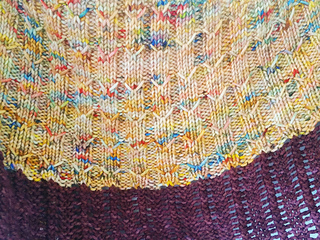patterns >  Shanel Wu's Payhip Store and 1 more...
Shanel Wu's Payhip Store and 1 more...
> Sandbloom









Sandbloom
This pattern is now available as a Ravelry download! It is still available as part of a kit by Krityum Handmade.
Krityum Handmade is a hand-dyed yarn and handmade notions shop by SS. She has used her talents to dye up two special colorways for this design! To order a Sandbloom Shawl kit, choose a colorway: “Cactus Flower” or “Mujave Desert”, then choose:
- DK or fingering weight
- a single color shawl or a two-color shawl (your choice of contrasting skein)
Have you ever seen a desert in bloom? Many people think of a barren, punishing land when they think of a “desert”. Yet in my native Mojave Desert surrounding Las Vegas, the landscape comes alive after a rainstorm. Hardy, spiky cacti suddenly sprout delicate, bright flowers that last for a few glorious days in the sun before fading into memory. This shawl is inspired by various flowering plants in the Mojave. The textured stitch patterns evoke barrel cacti, sagebrush branches, and prickly pears while the shape mimics the asymmetrical, yet beautiful, way that these plants propagate.
The pattern is written for two sizes/weights: a cozy DK weight shawlette, and a full-size fingering weight shawl. Both versions can be worked in either one or two colors, for a total of four possible shawls! Stitch counts and repeat numbers will be indicated in the format fingering (DK).
Materials
- Two 100g skeins of yarn, MC and CC (if making a one color shawl, both skeins are the same colorway)
- 40” or longer circular needle
- removable stitch marker
Yarn/Needle Size
fingering weight - 2 100g/460y skeins of Rozaana Socks, US5/3.75mm
DK weight - 2 100g/225y skeins of Cozy Sweater Light, US7/4.5mm
Techniques
This pattern is intended for an advanced beginner or intermediate knitter with experience with simple lace techniques (yo, k2tog, ssk), picking up stitches, and slipping stitches. Written instructions are provided for decreases and increases beyond the basics.
16 projects
stashed
7 times
36 projects
stashed
26 times
- First published: April 2017
- Page created: May 6, 2017
- Last updated: April 14, 2021 …
- visits in the last 24 hours
- visitors right now




